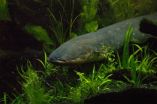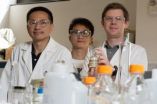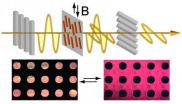(Press-News.org) The Institute for Basic Science (IBS) has announced that the Center for Self-assembly and Complexity have succeeded in developing a new technology that introduces metal nanoparticles on the surface of polymer nanocapsules made of cucurbit[6]uril.
The researchers have found that using polymer nanocapsules made of cucurbit[6]uril and metal salts can serve as a versatile platform where equal sized metal nanoparticles can be evenly distributed on the surface of the polymer nanocapsules. Cucurbit[6]uril has properties which strongly and selectively recognize organic and inorganic chemical species. This makes it possible to use it as a protecting agent which can stabilize metal nanoparticles by preventing them from clustering together. The metal-nanoparticle-decorated polymer nanocapsules exhibit the following properties in water: high stability for up to 6 months; high dispersibility; excellent catalytic activity; and reusability in carbon-carbon and carbon-nitrogen bond-forming reactions with 100% conversion efficiency.
Even though metal nanoparticles are variously used in industrial, pharmaceutical and agricultural (fertilizer) applications as a catalyst, toxic liquids such as toluene and hexane are usually used as solvents in the carbon-carbon and carbon-nitrogen bond-forming reactions. These toxic liquid solvents raise many issues for concern including environmental pollution, high cost of disposal, health problems and poisoning during the disposal process.
However, this new technology is able to replace those toxic liquids as it allows carbon-carbon and carbon-nitrogen bond-formation with the use of metal nanoparticles as a catalyst, which has high stability in environmentally preferable solvents such as water.
"The research results demonstrated that this new technology shows high stability, dispersibility, catalytic activity, and reusability in water, which other existing metal nanoparticles on solid supports have not been able to do," says Kimoon Kim, director of the Center for Self-assembly and Complexity at IBS. "It is important as it presents new possible applications in green solvents or bioimaging and nanomedicine fields."
INFORMATION:http://onlinelibrary.wiley.com/doi/10.1002/anie.201403438/abstract END
Eco-friendly versatile nanocapsules developed
2014-06-26
ELSE PRESS RELEASES FROM THIS DATE:
Do people with autism struggle with driving?
2014-06-26
PHILADELPHIA (June 26, 2014)— In the first pilot study asking adults on the autism spectrum about their experiences with driving, researchers at Drexel University found significant differences in self-reported driving behaviors and perceptions of driving ability in comparison to non-autistic adults. As the population of adults with autism continues growing rapidly, the survey provides a first step toward identifying whether this population has unmet needs for educational supports to empower safe driving – a key element of independent functioning in many people's lives.
"Previous ...
Scientists find potential new use for cancer drug in gene therapy for blood disorders
2014-06-26
LA JOLLA, CA – June 26, 2014 – Scientists working to make gene therapy a reality have solved a major hurdle: how to bypass a blood stem cell's natural defenses and efficiently insert disease-fighting genes into the cell's genome.
In a new study led by Associate Professor Bruce Torbett at The Scripps Research Institute (TSRI), a team of researchers report that the drug rapamycin, which is commonly used to slow cancer growth and prevent organ rejection, enables delivery of a therapeutic dose of genes to blood stem cells while preserving stem cell function.
These findings, ...
Awareness month spurs web searches for autism
2014-06-26
PHILADELPHIA (June 26, 2014)—Autism Awareness Month each April brings blue lights and puzzle shapes out to shine in many communities – but does it actually lead to increased autism awareness? According to a new analysis of web search trends by researchers at Drexel University, it does appear to drive an increase in Google searches for autism – by a third over searches in March in recent years.
Brian K. Lee, PhD, an assistant professor in the Drexel University School of Public Health and research fellow of the A.J. Drexel Autism Institute, was senior author of the study ...
New infections cause dormant viruses to reactivate
2014-06-26
GAINESVILLE, Fla. — The famous slogan is "A diamond is forever," but that phrase might be better suited to herpes: Unlike most viruses, which succumb to the immune system's attack, herpes remains in the body forever, lying in wait, sometimes reactivating years later.
Researchers have long wondered what causes herpes viruses — two strains of which are linked to cancer — to reactivate after remaining dormant once the initial infection resolves. Now a team of researchers, including two University of Florida scientists, has discovered that interactions with other infections ...
Fighting parasitic infection inadvertently unleashes dormant virus
2014-06-26
Signals from the immune system that help repel a common parasite inadvertently can cause a dormant viral infection to become active again, a new study shows.
Further research is necessary to understand the clinical significance of the finding, but researchers at Washington University School of Medicine in St. Louis said the study helps illustrate how complex interactions between infectious agents and the immune system have the potential to affect illness.
The results appear online June 26 in Science Express.
The scientists identified specific signals in mice that ...
Sequencing electric eel genome unlocks shocking secrets
2014-06-26
EAST LANSING, Mich. — For the first time, the genome of the electric eel has been sequenced. This discovery has revealed the secret of how fishes with electric organs have evolved six times in the history of life to produce electricity outside of their bodies.
The research, published in the current issue of Science, sheds light on the genetic blueprint used to evolve these complex, novel organs. It was co-led by Michigan State University, University of Wisconsin-Madison, University of Texas-Austin and the Systemix Institute.
"It's truly exciting to find that complex ...
Water-cleanup catalysts tackle biomass upgrading
2014-06-26
Rice University chemical engineer Michael Wong has spent a decade amassing evidence that palladium-gold nanoparticles are excellent catalysts for cleaning polluted water, but even he was surprised at how well the particles converted biodiesel waste into valuable chemicals.
Through dozens of studies, Wong's team focused on using the tiny metallic specks to break down carcinogenic and toxic compounds. But his latest study, which is available online and due for publication in an upcoming issue of the Royal Society of Chemistry's journal Chemical Science, examined whether ...
Not much force: Berkeley researchers detect smallest force ever measured
2014-06-26
What is believed to be the smallest force ever measured has been detected by researchers with the Lawrence Berkeley National Laboratory (Berkeley Lab) and the University of California (UC) Berkeley. Using a combination of lasers and a unique optical trapping system that provides a cloud of ultracold atoms, the researchers detected a force of approximately 42 yoctonewtons. A yoctonewton is one septillionth of a newton and there are approximately 3 x 1023 yoctonewtons in one ounce of force.
"We applied an external force to the center-of-mass motion of an ultracold atom ...
Let there be light: Chemists develop magnetically responsive liquid crystals
2014-06-26
RIVERSIDE, Calif. — Chemists at the University of California, Riverside have constructed liquid crystals with optical properties that can be instantly and reversibly controlled by an external magnetic field. The research opens the door to display applications relying on the instantaneous and contactless nature of magnetic manipulation—such as signage, posters, writing tablets, and billboards.
Commercially available liquid crystals, used in modern electronic displays, are composed of rod-like or plate-like molecules. When an electric field is applied, the molecules rotate ...
Researchers conduct comprehensive review of treatments for depression in cancer patients
2014-06-26
Depression is common in cancer, up to half of all patients facing the disease experience depressive symptoms, ranging from mild to severe. When depression co-exists with cancer, patients may be at an increased risk of death from cancer and from suicide.
Antidepressants are commonly prescribed, but the evidence on their efficacy is mixed. The role of antidepressants in treating cancer-related depression has not been rigorously studied. To identify best practice for the treatment of depression in cancer, Dartmouth researchers completed a systematic review and meta-analysis ...






